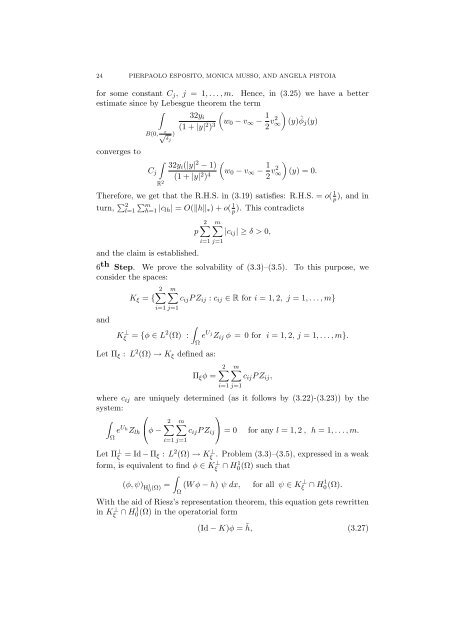CONCENTRATING SOLUTIONS FOR A PLANAR ... - CAPDE
CONCENTRATING SOLUTIONS FOR A PLANAR ... - CAPDE
CONCENTRATING SOLUTIONS FOR A PLANAR ... - CAPDE
Create successful ePaper yourself
Turn your PDF publications into a flip-book with our unique Google optimized e-Paper software.
24 PIERPAOLO ESPOSITO, MONICA MUSSO, AND ANGELA PISTOIA<br />
for some constant C j , j = 1, . . . , m. Hence, in (3.25) we have a better<br />
estimate since by Lebesgue theorem the term<br />
∫<br />
(<br />
32y i<br />
(1 + |y| 2 ) 3 w 0 − v ∞ − 1 )<br />
2 v2 ∞ (y) ˆφ j (y)<br />
converges to<br />
B(0, √ ε )<br />
δ j<br />
∫<br />
32y i (|y| 2 (<br />
− 1)<br />
C j<br />
(1 + |y| 2 ) 4 w 0 − v ∞ − 1 )<br />
2 v2 ∞ (y) = 0.<br />
R 2<br />
Therefore, we get that the R.H.S. in (3.19) satisfies: R.H.S. = o( 1 p<br />
), and in<br />
turn, ∑ 2 ∑ mh=1<br />
l=1 |c lh | = O(‖h‖ ∗ ) + o( 1 p<br />
). This contradicts<br />
and the claim is established.<br />
2∑ m∑<br />
p |c ij | ≥ δ > 0,<br />
i=1 j=1<br />
6 th Step. We prove the solvability of (3.3)–(3.5). To this purpose, we<br />
consider the spaces:<br />
and<br />
2∑ m∑<br />
K ξ = { c ij P Z ij : c ij ∈ R for i = 1, 2, j = 1, . . . , m}<br />
i=1 j=1<br />
∫<br />
Kξ ⊥ = {φ ∈ L 2 (Ω) :<br />
Let Π ξ : L 2 (Ω) → K ξ defined as:<br />
Ω<br />
e U j<br />
Z ij φ = 0 for i = 1, 2, j = 1, . . . , m}.<br />
2∑ m∑<br />
Π ξ φ = c ij P Z ij ,<br />
i=1 j=1<br />
where c ij are uniquely determined (as it follows by (3.22)-(3.23)) by the<br />
system:<br />
∫<br />
Ω<br />
e U h<br />
Z lh<br />
⎛<br />
⎝φ −<br />
2∑<br />
m∑<br />
i=1 j=1<br />
c ij P Z ij<br />
⎞<br />
⎠ = 0 for any l = 1, 2 , h = 1, . . . , m.<br />
Let Π ⊥ ξ = Id − Π ξ : L 2 (Ω) → Kξ ⊥ . Problem (3.3)–(3.5), expressed in a weak<br />
form, is equivalent to find φ ∈ Kξ<br />
⊥ ∩ H1 0 (Ω) such that<br />
∫<br />
(φ, ψ) H 1<br />
0 (Ω) = (W φ − h) ψ dx, for all ψ ∈ Kξ ⊥ ∩ H0 1 (Ω).<br />
Ω<br />
With the aid of Riesz’s representation theorem, this equation gets rewritten<br />
in Kξ<br />
⊥ ∩ H1 0 (Ω) in the operatorial form<br />
(Id − K)φ = ˜h, (3.27)





